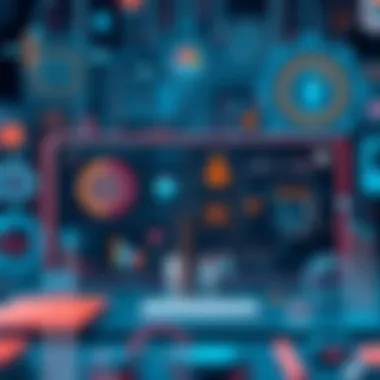Rethinking Gender: The Evolving Discourse and Its Impact


Intro
The conversation about gender has seen an exponential shift, akin to a tectonic plate moving under our feet. As society evolves, so too does the understanding of gender, once rigidly defined. This isn't merely a surface-level change but a profound transformation enveloping history, culture, and social dynamics. With technology at the helm, the traditional views of male and female roles are increasingly being challenged by a broader spectrum of identity.
In this examination, we take a meticulous look at the undercurrents driving this discourse. From the past's constricting frameworks of gender, shaped by culture and societal expectations, to the current shifts fostered by technology and social movements, we aim to discuss what these changes mean for education, legal frameworks, and even mental health. Through various lenses, we will explore what it constructs to rethink gender and the significance of such a re-evaluation in our modern context.
Historical Context of Gender Constructs
Understanding the historical context of gender constructs is crucial to the conversation about gender today. This topic sheds light on how traditional roles and expectations regarding gender have morphed throughout history, heavily influenced by social, economic, and political changes. By examining the past, we can better appreciate the current debates surrounding gender identity and expression. The evolution of these constructs has far-reaching implications, affecting various sectors such as education, legal frameworks, and mental health support.
Evolution of Gender Roles
The evolution of gender roles is a tale as old as time, marked by transformations rooted in both cultural and socioeconomic developments. Initially, societies divided labor based on biological differences, leading to a clear demarcation of male and female roles. For instance, men were often shepherds, hunters, or warriors while women bore the responsibility of nurturing the family and managing domestic tasks.
Fast forward to the Industrial Revolution, whereby rapid modernization began to chip away at those rigid roles. Women started working in factories and contributing to the economy in ways that were previously unheard of. This change didn't come without resistance, as traditionalists viewed women stepping outside their homes as an affront to societal norms. The post-war era further accelerated this shift, with more women entering the workforce, marking the beginning of a slow redefinition of gender roles.
Influence of Feminism
The influence of feminism on gender constructs is monumental and deserves recognition. The feminist movements, particularly in the 20th century, have been staged in waves to advocate for women's rights. Early feminists like Mary Wollstonecraft laid the groundwork by arguing for women's education and equality. Fast forward to today, and feminism has expanded its focus to include various interpretations of gender, striving for inclusivity.
In recent decades, feminist movements have pushed boundaries, arguing that gender is not binary but exists on a spectrum. This expansion prompts society to rethink traditional notions of masculinity and femininity, pushing toward a more inclusive understanding of gender identity.
Patriarchy and its Legacy
The legacy of patriarchy has cast a long shadow over gender constructs, influencing societal norms, values, and structures. For centuries, patriarchal systems have prioritized men's voices and experiences over those of women and non-binary individuals. This system is not merely a relic of the past; it is evident in contemporary issues such as pay gaps, representation in leadership roles, and societal expectations of behavior based on gender.
The consequences of patriarchal structures are profound. For example, the pressures on men to conform to ideals of toughness and emotional stoicism often lead to detrimental mental health outcomes. Meanwhile, women and non-binary individuals continue to confront biases and restrictions that limit their opportunities.
By critically examining the intricacies of patriarchal influence in historical contexts, we can better understand modern inequities and advocate for change. The dismantling of these constructs requires not just acknowledgment but active participation from all individuals, seeking equity and understanding.
"The first step in healing a society is to recognize its wounds." - Anonymous
By diving deep into these historical threads, we can piece together a richer view of both past and present gender constructs. This grounding lays the necessary foundation for examining how these constructs are being redefined today, guiding our exploration through cultural perspectives, technology, and social movements that continue to drive change.
Cultural Perspectives on Gender
Understanding gender through the cultural lens is crucial in untangling the complex layers that define our experiences. Different societies harbor unique norms and beliefs around gender, which can heavily influence individual identity and behavior. The importance of cultural perspectives lies not just in recognizing these differences but in appreciating how they shape thought patterns, societal structures, and expectations.
Cultural perspectives can also illuminate the effects of globalization and technology on traditional gender roles. As information crosses borders at lightning speed, the exchange of ideas leads to evolving understandings of gender identity.
Global Variations in Gender Identity
Gender identity varies significantly around the world, often shaped by rich historical contexts and contemporary beliefs. In some cultures, gender exists as a spectrum rather than a binary. For instance, the indigenous cultures of North America recognize Two-Spirit individuals, who embody both masculine and feminine traits. Similarly, cultures in South Asia frequently celebrate Hijras, a community that navigates between male and female identities. Such examples remind us that gender isn't confined to Western binaries.
However, challenges persist in many societies, where rigid gender norms still dominate. Some regions face backlash against non-binary or fluid identities, suggesting an ongoing struggle between tradition and the evolving understanding of gender.
Media Representation of Gender
Media serves as a powerful vehicle in shaping perceptions about gender. From advertisements to movies, the portrayal of gender drastically influences societal attitudes.
Historically, media has perpetuated stereotypical representations—females often depicted in nurturing roles, while males are seen as dominant. Even today, many films and advertisements lean on clichéd tropes instead of reflecting the multiplicity of gender experiences. However, the recent rise of diverse narratives on platforms like Netflix has opened doors for more authentic representation. Shows like "Orange is the New Black" and "The L Word" showcase characters navigating various gender identities, sparking dialogues about inclusivity.
As social media emerges as a new storytelling canvas, it provides a space for individuals to share their own narratives. Apps like Instagram and TikTok amplify diverse voices, allowing discussions about gender and identity to flourish.


Rituals and Gender Norms
Cultural rituals around the world often highlight entrenched gender norms. From rites of passage to religious ceremonies, these practices can either reinforce traditional gender roles or challenge them.
In many cultures, gender norms are defined during key life events. For example, quinceañera celebrations in Latin America honor a girl's transition into womanhood, reinforcing expectations about femininity. On the flip side, some communities utilize rituals to promote gender fluidity. The South Asian festival of Holi allows participants to break free from societal constraints, momentarily dissolving strict gender roles.
While these customs can foster community and belonging, they can also perpetuate expectations that may feel outdated. Individuals challenging these norms face backlash but also contribute to an ongoing conversation about the nature of gender itself.
"Culture is like a river: it shapes us, but we also change it as we navigate our lives."
In examining cultural perspectives on gender, it becomes clear that understanding the nuances across different societies offers a richer picture of identity formation. Each culture's approach to gender invites ongoing discussions, revealing the intricate interconnections between identity, society, and the ever-evolving dynamics of gender.
The Intersection of Technology and Gender
The fusion of technology and gender representation is a pivotal topic in contemporary discourse. As we navigate the digital landscape, the ways in which we express and understand gender are profoundly influenced by our engagements with technology. The phenomenon of digital spaces shaping identities cannot be overstated; these platforms serve not only as arenas for expression but also as catalysts for societal change.
Digital Identity and Gender Fluidity
In today's world, digital identity has become intricately linked with the concept of gender fluidity. For many individuals, the online arena offers a sanctuary where traditional binary notions of gender can be questioned and redefined. Social media platforms such as Instagram and TikTok have become crucial spaces for individuals to explore and represent their gender identities without fear of immediate real-world repercussions. The ability to curate one’s online persona allows for experimentation and self-discovery.
Furthermore, virtual environments have nurtured communities that embrace non-conformity, facilitating connections with like-minded individuals who may be geographically dispersed. Platforms like Reddit host discussions that examine the nuances of gender identity, creating awareness and acceptance through shared experiences. As people present diverse aspects of their gender identities, they challenge conventional norms, fostering a culture that is increasingly accepting and supportive of fluidity.
Impact of Social Media on Gender Perception
Social media’s influence on gender perception is profound and multifaceted. Elements such as algorithms, visual culture, and user-generated content shape how society perceives gender roles. For instance, the rise of influencers who defy traditional gender norms has brought visibility and validity to non-binary identities, transforming public discourse.
Moreover, interactions on these platforms often lead to a phenomenon known as "performative gender," where individuals consciously or unconsciously portray specific gendered behaviors or aesthetics that cater to an online audience. This can blur the lines of authentic expression as users weigh social acceptance against their true selves.
"Social media is akin to a double-edged sword; it empowers yet complicates gender identity representation."
Additionally, backlash against certain gender expressions is prevalent on these platforms, which draws attention to ongoing societal struggles. Users often find themselves at the intersection of activism and personal expression, promoting discussions on toxic masculinity, feminism, and the spectrum of gender identities.
Emerging Technologies and Gender Expression
The realm of emerging technologies presents new avenues for gender expression that were previously unimaginable. Virtual reality (VR) and augmented reality (AR) open doors to immersive experiences that allow users to embody identities beyond their physical realities. These technologies challenge perceptions by enabling one to engage in various gendered presentations within a virtual space.
Artificial intelligence also plays a role in shaping gender expression. AI-driven platforms can provide customization options that allow users to experiment with gendered aesthetics in unique and personalized ways. People might choose avatars that reflect their true selves or reject societal norms entirely.
However, the advent of these technologies raises important ethical questions regarding representation, accessibility, and authenticity. In creating a digital world where gender expressions thrive, one must consider who gets to define these identities and who controls the narratives surrounding them.
Social Movements Driving Change
Social movements play a crucial role in challenging and reshaping societal perspectives on gender. They are often the engines of change that push traditional boundaries and encourage new ways of understanding gender identity. The late 20th and early 21st centuries have witnessed a surge in activism related to gender, stemming from grassroots efforts that echo deeply within cultural contexts. These movements advocate not only for the rights and recognition of various gender identities but also encourage broader societal reflection on what gender means in contemporary society.
The importance of social movements lies not just in their direct impact, but also in their ability to shift public consciousness. They foster an environment where previously marginalized voices gain agency and visibility. By challenging institutional norms, these movements have instigated conversations that transcend traditional definitions of gender, thus reshaping the narrative around identity.
Rise of Non-Binary Identities
The rise of non-binary identities marks a significant departure from the rigid male-female dichotomy that has dominated gender discourse for centuries. Non-binary individuals identify outside this binary framework, embodying a spectrum of gender expressions that may fall anywhere along it or beyond it entirely. This shift is not merely theoretical; it has real implications for how we structure societal norms and facilities.
Research indicates that increasing visibility leads to greater acceptance. Non-binary representations in pop culture, social media platforms, and public discourse are essential in normalizing these identities. However, the journey is fraught with challenges. Misunderstandings and societal push-back still emerge, revealing the need for sustained advocacy and education.
"We’re in a time where people start to see gender as something fluid, not static — it’s refreshing yet essential for inclusivity."


Trans Rights and Advocacy
Trans rights and advocacy have fundamentally catalyzed a re-examination of legal and social frameworks pertaining to gender. The quest for rights spans various sectors, from healthcare access to legal recognition of gender identity. Meanwhile, trans activists have worked collaboratively within broader social movements to highlight the intersectionality of gender with race, class, and sexual orientation.
Key victories have emerged in recent years; numerous countries have adopted policies allowing for gender self-identification, affirming that individuals should have the right to determine their own identity without bureaucratic hurdles. This progress reinforces the need for continuous mobilization as disparities continue to exist, particularly for trans individuals of color and those in marginalized communities.
Intersectionality in Gender Activism
Intersectionality is a powerful concept in gender activism, illuminating how various forms of discrimination overlap and compound. It recognizes that one’s experience with gender cannot be evaluated in isolation from factors such as race, ethnicity, socioeconomic status, and sexuality. Many activists acknowledge that mainstream gender discussions often neglect the lived realities of individuals at these intersections.
Organizations that adopt an intersectional approach work towards inclusive activism, ensuring that the voices of all individuals, particularly those who belong to multiple marginalized groups, are represented. This shift compels us to confront uncomfortable truths about privilege while fostering a more nuanced understanding of liberation.
The role of social movements in driving change is paramount. They not only reshape public discourse; they also facilitate legal reforms, swing open doors to more inclusive practices, and ultimately encourage society to rethink deeply entrenched beliefs about gender. As we observe these shifting dynamics, it's essential to engage with and understand the complex interactions at play in the evolution of gender identity.
For more on intersectionality and gender activism, you can check Wikipedia or read more about digital platforms influencing gender Dialogues on sites like Reddit and Facebook.
Implications of Gender Paradigm Shift
The implications of the gender paradigm shift reach far and wide, touching multiple facets of modern life. As society discards rigid binaries and embraces a spectrum of identities, the consequences ripple through education, legislation, and mental health. This transformation isn't just a minor adjustment; it’s a rethinking of what gender means in a contemporary context. It invites discussions that question long-held beliefs, pushing both individuals and institutions to adapt.
When traditional views are challenged, opportunities arise to create environments that are more inclusive and equitable. For example, in educational settings, the need to reassess curriculums and teaching methodologies comes to the forefront. Additionally, legal frameworks must evolve to protect and empower recognizing diverse identities rather than merely classifying them within outdated paradigms.
Further, the shift influences mental health. Many individuals face psychological struggles stemming from societal expectations aligned with rigid gender roles. Therefore, understanding these implications is crucial, as it facilitates the support systems needed for everyone. By examining how society embraces or resists this shift, we can learn to navigate the potential challenges and benefits that will define the future.
Effects on Education Systems
The education system, often seen as a bedrock of society, is undergoing a noteworthy transformation due to the emerging concepts surrounding gender. Historically, curricula have been rooted in binary notions of gender, reinforcing stereotypes that hinder true understanding and acceptance. However, there is a growing recognition of the necessity to redesign educational approaches.
- Curriculum Development: Educators are beginning to weave gender inclusivity into the fabric of academic programs. This isn’t just about updating sex education classes; it extends into literature, history, and art. The goal is to expose students to a variety of gender identities and experiences, providing a more rounded understanding of the world.
- Training for Educators: Teachers and administrative staff must also be equipped with the necessary training to foster a supportive environment for all students. Inclusive language and recognition of diverse identities can create a sense of belonging that encourages learning.
- Safe Spaces: Schools are implementing safe spaces, where students can explore their identities without fear of judgment. This kind of environment fosters communication and understanding, as students learn to navigate their differences constructively.
It's essential that educational institutions embrace these changes for the betterment of all students. By doing so, they lay the groundwork for a more understanding and compassionate society.
Legal Framework and Gender Equality
The legal landscape surrounding gender is gradually shifting, reflecting a growing acknowledgment of diverse gender identities. This shift necessitates a thorough reevaluation of existing laws and regulations, as they often fail to address the complexities that accompany non-binary and transgender identities.
- Anti-discrimination Laws: Inclusion of specific legal protections for gender non-conforming individuals is crucial. Current anti-discrimination laws often fall short, as they may only cover binary notions of gender. A movement towards broader definitions is essential for true equality.
- Recognition of Gender Identity: Policies need to evolve by allowing individuals to self-identify on official documents such as licenses and birth certificates. This simple yet profound change can help individuals feel recognized and respected.
- Legal Support and Resources: The judicial system must have adequate resources for gender-related cases. Courts and law enforcement agencies need training on recognizing biases and understanding the complexities of gender identity issues to ensure fair treatment of all individuals.
Legally enshrining the rights of those who do not conform to traditional gender norms empowers them and inspires others to advocate for equality. This transformation is not merely a response to social pressure; it is a recognition of human dignity in all its expressions.
Mental Health Perspectives
With the changing landscape of gender identities comes an imperative to address the mental health implications of these shifts. Many individuals, particularly those who identify outside the traditional gender framework, experience unique challenges that can impact their mental wellbeing.
- Stigma and Discrimination: Non-conformity often leads to stigma. Individuals may face rejection, bullying, or even violence, all of which can yield long-lasting psychological effects. Understanding these impacts is vital in developing targeted mental health resources.
- Access to Care: Mental health services should be tailored to meet the unique needs of gender-diverse individuals. Providing professionals who are educated about gender dysphoria and the emotional effects of societal rejection can lead to better outcomes.
- Community Support: Fostering a sense of community is invaluable for mental health. Support groups and resources that connect individuals with similar experiences can create a platform for shared healing and understanding.
Addressing mental health within the context of evolving gender norms isn’t just a necessity; it’s a moral and ethical duty. A society that values all forms of identity inherently promotes the health and wellbeing of its members.
"The future belongs to those who believe in the beauty of their dreams." - Eleanor Roosevelt
As we navigate the complexities of this gender paradigm shift, the implications extend well beyond theoretical discussions. Each element, whether it be the educational system, legal enactments, or mental health, contributes to a landscape that welcomes diversity, allowing individuals to express their true selves.
Philosophical Considerations


When peering into the intricate realm of gender, philosophical considerations provide the framework for understanding the significance behind evolving identities. Philosophers have long pondered the nature of being and identity, and applying this inquiry to gender prompts deeper reflection on how social constructs shape personal experiences. Delving into these considerations sheds light on the complexities of gender identity, ultimately allowing for a richer dialogue about who we are as individuals and how we navigate our lives in relation to one another.
Existentialism and Gender
Existentialism, with its focus on individual experiences and freedom, offers unique insights into gender. This philosophy posits that existence precedes essence, meaning that individuals create their own identities through choices and actions. In terms of gender, this perspective is particularly empowering. It suggests that gender isn't necessarily something one is born into, but rather can be molded and shaped through personal decisions and societal influences.
By directing attention to individual experiences, existentialism allows for a more nuanced understanding of gender fluidity. Take, for example, the personal narratives shared by individuals who identify as non-binary. Their stories underscore the notion that gender can be an expansive, almost kaleidoscopic experience rather than a restrictive binary classification. The dialogue fostered by existentialist thought can encourage acceptance of diverse identities, challenging the rigidity of traditional gender norms.
Foucault's View on Identity
Michel Foucault's theories on power and identity further illuminate the philosophical considerations surrounding gender. Foucault argued that identity is constructed through discourse and shaped by societal power structures. This framework implies that the norms surrounding gender are influenced by broader cultural narratives—think of how historical events shape contemporary understanding.
In Foucault's view, gender identity isn't merely an intrinsic characteristic; it's sculpted through interactions with social institutions, such as education, family, and government. For instance, the discourse surrounding LGBTQ+ rights has shifted dramatically in recent years, which in part reflects wider societal changes. As arguments for equality gain traction, the conversations around gender identity evolve, revealing how fluid our understanding can be when placed in the context of existing power dynamics. Engaging with Foucault's theories helps dismantle the existing constructs, allowing space for redefinition and synthesis of gender identity that reflects a myriad of experiences.
The Role of Language in Gender Construction
Language serves as one of the most powerful tools for expressing and constructing gender identity. The terms we use shape how we think about and understand gender. For instance, the emergence of gender-neutral pronouns like "they" reflects a growing recognition of diverse identities and challenges traditional binaries.
Furthermore, the way language evolves in response to societal changes highlights its role in constructing gender norms. As individuals begin to embrace non-binary identities, the language surrounding these identities must also shift. This can be seen in media and literature, where new narratives are emerging, challenging established norms and giving voice to previously marginalized identities.
Language is not only a means of communication, but it also shapes our reality. The fight for inclusive terminology signifies a broader struggle for recognition and acceptance.
Incorporating different terms and perspectives into everyday language not only fosters acceptance but also encourages individuals to interrogate their own identities and biases. This exploration ultimately leads to more inclusive environments where diverse gender identities can exist freely.
In sum, philosophical considerations encourage us to rethink and reassess our understanding of gender within the wider cultural and social frameworks. By engaging deeply with existentialism, Foucault’s theories, and the impact of language, we can foster dialogue that transcends traditional boundaries and opens pathways to more authentic expressions of identity.
Future Perspectives
As we delve into the future perspectives surrounding gender, it's paramount to acknowledge the shifting tides of societal understanding. The importance of this topic is profound. With changing cultural landscapes and the relentless pace of technological advancement, the concept of gender is undergoing a metamorphosis.
This section explores three pivotal themes: predictions for gender norms, the role of technological innovations in shaping gender identity, and the influence of global movements on gender perceptions. Such analysis sheds light on how future engagements with these factors could redefine gender understanding in both subtle and overt ways.
Predictions for Gender Norms
Over the next couple of decades, it's likely that traditional notions of gender will continue to dissolve. Predictions indicate that gender norms will not only diversify but also become more fluid. Current trends show a growing acceptance of non-binary identities, suggesting that future generations may freely embrace a spectrum of gender expressions.
Education systems are already adapting, with curricula becoming more inclusive of diverse gender identities. Students may encounter discussions around gender from an early age. This shift isn't merely about erasing old norms; it also envisions a society where individuals are empowered to define their identities in their own terms.
Moreover, as more people share their experiences online, the collective voice will fuel advocacy for gender equality and representation. The importance of creating safe spaces for these discussions cannot be overstated, as they will foster understanding and validation for those who exist outside the traditional binary framework.
"The future of gender is about claiming space for all identities, fostering understanding, and appreciating diversity in self-expression."
Technological Innovations and Gender Identity
The marriage between technology and gender identity is blossoming. Emerging tech is opening unprecedented avenues for expression and exploration. For instance, virtual and augmented reality platforms allow individuals to experiment with their identities in immersive environments, often far removed from traditional societal constraints.
Furthermore, digital personas are reshaping how people perceive themselves. Online avatars can be representative of one's true self, regardless of physical attributes. Blockchain technology may also provide secure spaces for documenting and recognizing diverse identities without the risk of misrepresentation or fraud.
Social media platforms are instrumental in amplifying gender discussions, too. From hashtags that mobilize support to platforms that celebrate queer artistry, technology enables a global conversation on gender identity. Yet, while tech fosters progress, it also sparks debates on privacy and the ethics of representation. Balancing innovation with responsibility will be essential moving forward.
Global Movements and their Impact on Gender Understanding
In recent years, global movements have emerged that profoundly impact our understanding of gender. These movements resonate across borders, uniting individuals around the globe in their quest for equality. The #MeToo movement, for instance, has not only raised awareness about sexual harassment but has also broadened the discourse regarding gender-based power dynamics, challenging patriarchal structures worldwide.
Additionally, activism surrounding trans rights is gaining momentum, pushing for policy changes and societal acceptance in various regions. Countries that exhibit this shift often become models for others, illustrating how collective action can lead to legal reforms and enhanced societal inclusivity.
As previously distinct cultures begin to collaborate around shared values, the blending of perspectives prompts a richer dialogue concerning gender. Shared stories of struggle and triumph break down barriers, creating awareness and empathy among diverse populations. Such global movements not only shape local norms but also help in constructing a more interconnected understanding of gender on a larger scale.
The interplay of these themes not only illustrates the current landscape but also acts as a compass for our future interactions with gender. Fostering ongoing dialogues about these shifts can pave the way for a more inclusive, nuanced world, where gender isn't confined to a rigid definition but is instead an evolving tapestry of human experience.







